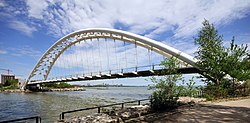Humber Bay Arch Bridge | |
|---|---|
 The Humber Bay Arch Bridge seen from the west bank of the Humber River | |
| Coordinates | 43°37′55″N79°28′16″W / 43.631896°N 79.471246°W |
| Carries | pedestrian & bicycle traffic |
| Crosses | Humber River |
| Locale | Toronto |
| Maintained by | Toronto Transportation Services [1] |
| Characteristics | |
| Design | Double-ribbed arch bridge [1] |
| Material | Steel tubes [2] |
| Total length | 130 metres (430 ft) [2] |
| Height | 21.3 metres (70 ft) above grade [1] |
| Longest span | 100 metres (330 ft) [2] |
| No. of spans | 1 |
| Piers in water | 0 |
| History | |
| Designer | Montgomery and Sisam Architects [1] |
| Construction end | 1994 [1] |
| Location | |
 | |
The Humber Bay Arch Bridge (also known as the Humber River Arch Bridge, the Humber River Pedestrian Bridge, or the Gateway Bridge) is a pedestrian and bicycle through arch bridge south of Lake Shore Boulevard West in Toronto, Ontario, Canada. Completed in the mid-1990s, the bridge is part of the Martin Goodman Trail and is 139 metres (456 ft) in length, with a clear span of 100 metres (330 ft) over the mouth of the Humber River to protect the environmental integrity of the waterway.
